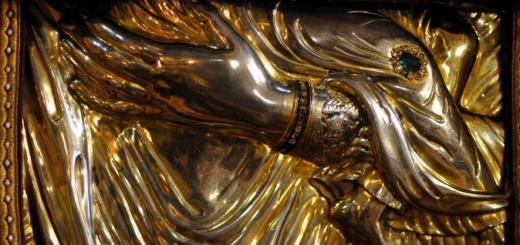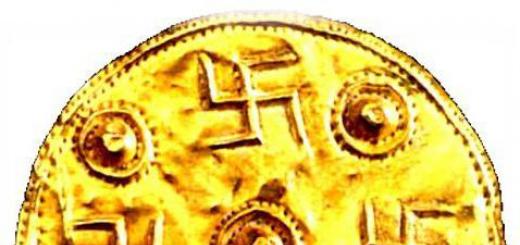William Blake. newton
Isaac Newton (1642-1727) became in our mind the founder and symbol of a new generation of science - rational, quantitative, precise. The cult of Newton began to take shape during his lifetime, which the elderly Newton himself contributed to. The poet Alexander Pope summed up the essence of the Newtonian cult in his almost-serious epitaph:
Order nature, its law hid in the eternal darkness.
And God said: “Appear, Newton!”, and light spilled everywhere.
This cult and the myths associated with it still surround Newton's personality. And the historical Newton was firmly connected with the science and society of his time. His work and life were not a turning point, but a turning point. A detailed account of Newton's biography is beyond the scope of a brief essay, so we will discuss here only the features of the turn that Newton made in the context of his time.
Isaac Newton was born on the estate of Woolstrop (East Anglia) in the family of a wealthy sheep farmer, showed early aptitude for science and was, after hesitation, sent by his mother to Trinity College, Cambridge University, where he spent almost all of the next 30 years. Initially, Newton was a "subsizer" - a poor student who practiced his studies by serving older students; Newton was an assistant to a distant relative of Humphrey Babington (See documents of the Newton Collection of the Cambridge Library and commentaries). In 1664, he passed the examination for a scholarship, which gave the right to study for three years for a master's degree, and a year later became a bachelor.
In 1660, the Restoration began in England. Disappointed by the regime of the father and son of the Cromwells, the English elite returned to the royal throne the sons of the executed Charles I Stuart, Charles II and James II. The monarchs sympathized with the Catholics, the subjects were Protestants. Parliament, and after it the country, was divided into factions of royalists (Tory, from the Irish "torai" - a robber), and Protestant oppositionists (Whigs, from the Scottish "wiggamore" - cattleman). The Restoration was a time of conflict and ended in 1689 with a “glorious revolution”, after which a constitutional monarchy was established in England, led by the now living Hanover Protestant dynasty (who changed their German surname to Windsor in 1914).
On the Continent, during the 17th century, the concept of the universe as a mechanism became increasingly popular. Most often, the Universe was likened to a clockwork, which symbolized the interdependence and harmony of the laws governing the Universe, and the universality of movement, primarily circular. Kepler's laws, Galileo's discovery of the moons of Jupiter, and his research into free fall made the problem of motion and constant change one of the most urgent problems. The time of new geographical discoveries and social movement also influenced the worldview of philosophers (which Francis Bacon directly wrote about in The New Organon).
The Cambridge of the Restoration was far from the intellectual life of Europe. They taught in the old fashioned way, in the spirit of late medieval Aristotelianism. Graduates became either priests or gentlemen (middle-ranking noblemen living on rent) and did not have scholarly ambitions. Modern ideas penetrated Cambridge, but were of interest to few.
The greatest influence on Newton at this time was made by Professor Isaac Barrow (Barrow), the first holder of the Lucas Chair of Mathematics founded in 1663, which was subsequently occupied and glorified by Babbage, Stokes, Dirac, Hawking - and immediately after him Newton. Barrow was engaged in optics and differential calculus and became a kind of "scientific adviser" for Newton.

Newton told one of his biographers how he pondered in the garden whether the same force that causes apples to fall to the Earth could also keep the Moon in low Earth orbit.
An anecdote is often mentioned in the literature that Newton allegedly leafed through Euclid's "Geometry" and said that it was so simple that it was not clear why it needed proof. But this story had a continuation: when in 1664 he appeared for an exam, Barrow pointed out gaps in his knowledge to him, and Newton had to study Geometry again and carefully before retaking (Arnold V.I. Huygens and Barrow, Newton and Hooke. - M .: Nauka, 1989). Newton's personal copy of "Geometry" is thickly covered with student notes. Subsequently, Newton also studied the "Geometry" of Descartes.
Soon after Newton became a bachelor, another outbreak of the plague came to England, and the University of Cambridge was quarantined. Newton took refuge from the plague at Woolstrop from 1665 to 1667, experimenting at home. According to Newton, it was at this time that he achieved all his main results in the field of optics, mechanics and differential calculus. This span is sometimes referred to as the "wonderful years". This, apparently, is an exaggeration: we have no other sources about this period in Newton's life, except for his letters and diaries, and they show a large series of various experiments, not always effective, and for the most part with results that need to be processed.
Many years later, Newton told one of his biographers how he pondered in the garden whether the same force that causes apples to fall to the Earth could also keep the Moon in orbit around the Earth. Whether this happened precisely during the “amazing years” has not yet been established. A version in which an apple fell directly on Newton's head, after which he allegedly cried out "Eureka" and discovered the law of universal gravitation, was published in 1738 by Voltaire, who was a great popularizer of science of his time, but preferred artistic expressiveness to historical accuracy.
In 1668, Newton returned to Cambridge and in 1670 took over the Lucas chair in place of Barlow, where his duties included a semester course of lectures on arithmetic, geometry and optics, one hour a week. According to his assistant Humphrey Newton (compatriot of the same name), Newton's lectures were not popular, and Newton often waited in an empty auditorium for about a quarter of an hour, after which he went home. The Cambridge audience had little interest in the subject and had difficulty understanding it. Newton spent most of his time at home doing laboratory work, sometimes making trips to Woolstrop, where he also worked, or to London. Humphrey Newton recalled that the work absorbed his boss so that he forgot about everything, and even about food.
During his time at Cambridge, Newton did all of his major research. In 1669, Newton presented his "leader" Barlow with a report "De analysi per aequationes numero terminorum infinitas" ( lat."On the analysis of infinite series by equations"), in which he derived the generalized binomial theorem. In 1679, Newton submitted a written copy of the Lectures on Optics to the Cambridge archives, and in February 1672, Secretary of the Royal Society, Henry Oldenburg, read Newton's letter at a meeting of the society with evidence of the composite nature of white. . Also in 1672, the Royal Society showed Charles II the world's first reflecting telescope, made by Newton.

The Granger Collection
Finally, in 1684-1686, Edmond Halley proposed to Newton to solve the problem that Robert Hooke had promised him to solve on a dare, to give a mathematical justification for the ellipticity of orbits according to Kepler. Newton makes calculations and first writes a note to Halley "De motu corporum in gyrum" ( lat."On the Revolution of Bodies in Orbit"), and then the three-volume book "Philosophiæ Naturalis Principia Mathematica" ( lat."The Mathematical Principles of Natural Philosophy"). It was Newton's first book, which was published, apparently for financial reasons - at first the Royal Society took over the budget for its publication, but in the end it was paid by Halley, who actively promoted Newton's report.
In the Elements, Newton outlined a new universal system of nature, where, on the basis of the law of universal gravitation and the three laws of interaction, not only Kepler's laws, but also many other phenomena of dynamics were accurately explained and calculated: the first volume was devoted to the motion of the planets and the oscillations of the pendulum, the second volume considered problems of hydrodynamics. The book made a very vivid impression on contemporaries, was sold out quite quickly (circulation from 250 to 400 copies sold out in three to four years), and from that moment Newton's public fame began to grow, first in England, and then in Europe.
For a long time, historians and readers were sure that Newton was engaged in physical and mathematical sciences in Cambridge, but in 1936 Newton's diaries were discovered that ran counter to this image. Before that, it was believed that all laboratory records for 30 years burned down in a fire in the laboratory, and Newton was so stressed by the loss that he fell ill with mental disorder for many months. But it turned out that there was no fire, the records are intact, and from them it follows that Newton from 1660 to 1692 spent most of his working time on alchemy, and all his greatest research occupied a smaller part of his efforts. Newton's disease may have been a neurological disorder from mercury vapor poisoning.
The economist John Maynard Keynes said of Newton that he was not the first scientist, but the last magician. This is an exaggeration. Alchemy, then already called "chemistry", but still confident in the possibility of creating gold from mercury and lead, was considered at that time a completely respected science and applied the same method of obtaining knowledge by experiment, which Newton brought to physics. But why Newton was engaged in alchemy so stubbornly and for a long time, we do not know for sure. Of all the possible hypotheses, the most credible and the most fitting to the razor of another great Briton, William of Ockham, is that Newton wanted to get rich. To eat on silver and ride in a carriage (symbols of wealth in the 17th century), neither a professorship nor a farm was enough. Newton quite rationally reasoned that he could make a fortune with his mind. In the early 1690s, Newton stopped devoting time to alchemy, most likely for personal reasons. According to tradition, the alchemist had to pass on "secret knowledge" to a trusted student. Newton probably nominated his assistant Nicolas Fatio de Duillier for this role, but Fatio did not appreciate the trust and left Newton in 1694, which was a great disappointment for Newton.
Newton moved away from science and teaching in connection with the end of the Restoration era. King James II, almost an open Catholic, began to attack the privileges of the Protestants, turning against himself the aristocracy, clergy and townspeople. The first attempt to overthrow the king was made in 1685 by his bastard nephew, Earl James of Monmouth. The rebellion failed, and Monmouth was beheaded, but the society of England did not give up. Newton joined the Whigs and in 1688 took an active part in resisting the royal decision to give a chair in Cambridge to a Catholic Benedictine monk, repeating almost verbatim the argument that would soon become the center of John Locke's political philosophy: "The king should be honored, but should not be obeyed by illegal command." At the end of 1688, the queen gave birth to an heir, and the Protestants decided on a new attempt at rebellion. The cousin of King William of Orange, who was married to the daughter of Charles II, Mary, was summoned from England. King James fled almost without a fight, the new king was installed on the throne under the name of William III, and a new parliament was hastily convened. These events immediately received the name of the "glorious revolution."
Isaac Newton also entered the new convocation at the Palace of Westminster as an MP for Cambridge (1689–1690). Contrary to another myth, Newton, sitting in Parliament, did not speak only once - with a request to close the window from the draft. Newton was not the most active parliamentarian, but served on parliamentary committees on religious minorities, participated in the preparation of the oath to King William and promoted decisions in the interests of Cambridge University, from which he was elected both times (the second time in the convocation of 1701-1702; see information about the work of I. Newton in Parliament).
After 1690, Newton actively sought a position in London, and eventually succeeded. The Treasurer of England, Charles Montagu (later Baron Halifax), who had the confidence of the new king, was Newton's junior colleague at Trinity College in the late 1670s, and perhaps the only student Newton was waiting for to begin his lecture. In 1696, through the efforts of Montagu Newton, he was appointed superintendent of the Mint in the Tower; the caretaker was second in command after the head of the Mint and was responsible for the operation of the minting machines and for the criminal prosecution of counterfeiters. Many years later, Voltaire recounted the London gossip that Newton only got the job because Montagu had an affair with Newton's smart and beautiful niece, Catherine Barton, but Catherine Barton did not arrive in London until a few years after Newton's appointment. Newton was appointed by old connections, for supporting the new king before the revolution - and in the hope that the recognized best scientist in England would solve a very difficult problem.

Engraving depicting a fire in Newton's laboratory
Almost all members of the Royal Society, including the philosopher John Locke, have been thinking about ways to save the British economy since 1694. Even under the Stuarts, English finances were in a deplorable state. The silver content of the pound was several percent lower than the cost of silver on the continent, and this brought to life a massive "coin clipping": craftsmen sawed off the coin along the side and resold the silver abroad.
From 1662 to 1694, there were two coins in circulation in England: one of the old type of hand-chased with an unprotected edge, the second of a new machine-made coin with a protected (“edge”). In fact, the turnover of the coin consisted almost entirely of bad old coins, because the British hid quality coins in strict accordance with Gresham's law. In 1694, it was almost impossible to find an uncircumcised shilling, the coins remaining in circulation were cut off by an average of 8-15%. Wilhelm III waged a sluggish and costly war with Catholic France, and at some point the army had to pay with provisions instead of coins, which simply did not remain in the country. The problem could be solved by making silver coins with a face value more expensive than the metal, but the value of the royal hallmark was not yet generally recognized, and the government decided to start a “great re-minting” of the old coin into a new, edged one. Unfortunately, the head of the Mint in the Tower could provide no more than 3-5% of the country's needs per year, and did not try very hard, considering his position as a sinecure.
From that moment on, Newton finally abandoned alchemy. First, since the 14th century, alchemy was legally considered a counterfeit of money, and Newton risked letting down his Whig associates. And secondly, the new position solved all Newton's material problems: the management of the Mint received a share of 3% of the minting volume. Newton's income at this place ranged from 1200 to 3000 pounds a year - the cost of a rich estate, an order of magnitude more than the income of a university professor (100-120 pounds a year). It was no longer necessary to breathe mercury and antimony in search of gold.
Newton did not engage in deep research at the Mint, but to some extent he used his experience as an experimenter and analyst. He timed production (centuries before "Taylorism") and made it take less than a minute to mint one coin. Newton began to accept old coins not at face value, but by weight. Newton also created a network of informers among counterfeiters, sending 28 of them to execution and hard labor in the colonies, and turned the case of one of them, William Chaloner, who had patrons among Newton's opponents, turned into a show trial. Chaloner is often presented in literature as the "king of counterfeiters" or the victim of political reprisals by Newton ( Levenson, Thomas. Newton and the counterfeiter. M. 2013). Both of these are most likely wrong. Chaloner was a major, but not the only counterfeiter, and not the only one Newton sent to the gallows. He is better known than others because Newton contributed to the publication of a pamphlet that glorified Newton as a terror of counterfeiters and demonized Chaloner.
By 1699, the recoinage was largely complete, and Newton was promoted to head of the Mint. In 1710-1711, he carried out the same recoining in Scotland, which joined England, and in 1717 entered Parliament with a proposal to introduce a new ratio of silver coins to gold, as a result of which Britain soon switched to a de facto gold standard. Newton retained the post of head of the Mint until his death. In May 1705, Newton was knighted by Queen Anne, who succeeded William III, during her visit to Cambridge. Newton received the prefix "sir" not at all for scientific merit. He was made a lord on the eve of the next parliamentary elections, partly for propaganda purposes, partly for services in the monetary business. The first scientist lord was the physicist and chemist Humphry Davy at the beginning of the 19th century.
This popular best-seller is rather loose with the facts and may be an example of how the author estimates Chaloner higher than his own facts allow. Having achieved wealth and position in society, Newton almost did not engage in science. In his declining years, in 1703, he headed the Royal Society and published generalizing works based on reports made in his youth. In 1704 "Optics" was published, in 1709 "Beginnings" were republished. A circle of scientists of the younger generation formed around Newton, who actively used and developed Newtonian methods of experimental research and mathematical analysis and glorified the genius of their teacher.
In 1713, Newton used his position to deprioritize Gottfried Leibniz's discovery of calculus; The Royal Society, of which Newton was the head, issued a diatribe against Newton in favor of Newton for a report allegedly made by an independent commission. Newton's actions were not something out of the ordinary: fierce disputes over priority were the norm for scientists of the 16th-18th centuries, Cardano, Huygens, Hooke encroached on other people's priorities, resorting to patronage was also considered acceptable. We now believe that Newton and Leibniz arrived at the discovery of the foundations of calculus independently, and Leibniz had the first publication. The main theorem of analysis (the Newton-Leibniz theorem) on the reversibility of differentiation and integration is first encountered by Barrow, and Newton and Leibniz formulated it in a formal form. But Leibniz, albeit posthumously, was justified in the "court of history": it was his notation (notation method) that became the standard language of mathematics, and Newton's notation with dots was preserved only in mechanics.
It is often incorrectly asserted that by old age Newton moved away from scientific rationalism to religiosity. This is a completely false description of Newton's relationship with religion. Not only did Newton receive theological training as part of his studies at Cambridge, but he read books on theology all his life (as his library catalog shows) and wrote on theological topics.
Difficulties with understanding the religious views and works of Newton arise because, since the end of the Enlightenment, there has been an understanding of science and religion as mutually exclusive intellectual fields, one of which is possible only through rational knowledge, and the other through irrational faith. So many conflicts of the past have been rethought in the spirit of this vision. We have already seen that in different epochs the attitudes of what belonged to the sciences and the understanding of religion changed greatly.
The concept of the Universe as a mechanism of the 17th and the first third of the 18th century was not atheistic. On the contrary, it explained the reasonableness of Creation and the perfection of the world created by God. To the question about the place of God in the Universe-mechanism, the most beautiful answer was given by Rene Descartes, who defined the role of God as a "first push". If the Universe is a clock, then someone created and started this clock. Newton himself gave a theological interpretation of his natural philosophy in this spirit at the end of the Principia.
Although Newton was the first Cambridge professor to receive royal dispensation from the priesthood, which was a formal requirement for a Cambridge teaching position, his scientific writings most likely had nothing to do with it. Newton privately held very idiosyncratic religious views and was apparently a Unitarian (did not accept the Trinity). There are disputes about his views, sometimes he is characterized as an Arian, sometimes as a Socinian. It is also sometimes claimed that Newton considered himself a prophet chosen by God and almost a messiah. Neither the university nor the king would like to listen to reproaches that a "heretic" has been elevated to the dignity and chair. The question of the purity of the faith of a professor-cleric was not idle in the era of the Restoration. Even the more accurate Gregorian calendar met with sharp resistance from the Protestants, who adhered to the Julian calendar with the words: “It is better to part with heaven than meet with the pope” ( the source and existence of this phrase is unknown, sometimes it is attributed to the Patriarch of Constantinople Jeremiah).
Two of Newton's most famous works on religion and theology are directly related to his mathematical and astronomical works. In his notes, calculations were found, according to which, according to the book of Daniel, the end of the world will come in 2060. And in 1728, Newton described an attempt to radically revise the biblical and mythological chronology on the basis of astronomical data in the direction of reduction based on calculations and astronomical data. This was one of the first attempts to use the methods of related sciences for the scientific study of history, although unsuccessful.
After Newton's death, his cult became massive and universal. Newton's works were commented on and retold, first in other scientific works, and then in a popular form. The popularizers of the 1730s and 1760s published the books A Simple Introduction to Newton's Philosophy, Newton's Philosophy for Ladies, and Newton's System of Philosophy Adapted to the Level of Young Gentlemen and Ladies by a certain "Tom of the Telescope" - that is, in fact, "Newton for children" (see archive of Newton's popularizers' publications). The Age of Enlightenment, which by the end of the 18th century had finally supplanted God with the concept of Reason, but had not yet got rid of the idolization of ideals, saw in Newton the prophet of the era of Reason and almost the sole creator of true physics and mathematics.
What was the main intellectual step forward that Newton made? As we already know, Newton did not discover the decomposition of light by a prism into a spectrum - he found out that the spectrum can be collected into white light by a second prism. Newton also did not single-handedly create mathematical analysis, although he made a very important contribution to it by discovering Newton's binomial and finding a general way to solve infinite series.
The main misconception that needs to be overcome is the frequent belief that Newton discovered the law of universal gravitation and Newton's three laws.
The topic of gravity was very popular in the science of the 17th century, starting with Kepler. Aristotle's thesis that movement is primary and "in the nature of things" by the middle of the 17th century also almost did not suit anyone. The law of universal gravitation belonged to Robert Hooke, who, in turn, formulated clearly what his predecessors had glimpsed as conjectures. The idea that the movement of celestial bodies is determined by rectilinear motion and falling to the center of their system was expressed in 1666 by Giovanni Borelli in his work "Theoricae Mediceorum planetarum ex causis physicis deductae" ("Theory of the Medician planets"), to which Newton refers, but how its working hypothesis was proposed by Wren at the very beginning of the dispute between Hooke and Halley. Newton also proved that the law of universal gravitation explains the ellipticity of the orbits of the planets. The nature of the gravitational force remained a mystery throughout the era of classical physics.
The three laws were also known before Newton, who only clearly stated them. The first law follows from the works of Galileo, the second - Descartes, and the third Newton gives with reference to Huygens. Newton did not discover "Newton's three laws", but used these three empirically discovered regularities as axioms in order to derive a number of physical regularities from them. Newton's work is built on the same principle as Euclid's Elements. Euclid derived all the theorems of geometry from basic axioms. Newton follows the same principle. The very title of Newton's work "Mathematical Principles of Natural Philosophy" refers simultaneously to the "Principles" of Euclid and to the work "Principia philosophiae" ( lat.“Principles of Philosophy”) by R. Descartes, whom Newton respected, but whose speculative concept of “vortex motion” he completely refuted with his work ( see Descartes, René. The origin of philosophy. part 3, paragraphs 46–51).
Newton's work did not describe experiments that are demonstrated at school on bars and suspensions. Newton investigated, first of all, the motion of celestial bodies and, secondly, a number of other cases of motion. And illustrative experiments based on his works were developed by popularizers and teachers of the middle of the 18th century, Willem Gravesande from Leiden University and Newton's student, laboratory assistant of the Royal Society, John-Theophilus Desagilliers.
Newton's mathematical methods are also not like those we are used to. The formula F = ma familiar to us is absent in this book, as well as the concept of mass in general. They arose later, in commentators and in expositions in subsequent periods. The Principia Mathematica contains very few mathematical formulas and a great deal of graphic evidence, just as Euclid did. The geometric proofs were at least somewhat accessible to Newton's audience, but they were almost guaranteed not to understand the formulas. Humphrey Babington, then a Fellow of Trinity College, upon receiving a copy of the Principia said, "It takes seven years of study to understand this book."
Newton is often credited with the quote: "I invent no hypotheses." The full sentence is longer: “I do not invent hypotheses. Whatever is not deduced from phenomena must be called a hypothesis; hypotheses of metaphysical, physical, mechanical, hidden properties have no place in experimental philosophy. Newton meant by "hypothesis" not the modern meaning of "setting a problem for experimental verification", but "a speculative theoretical construction that cannot be experimentally verified" - what we call "speculation". Here we can see a controversy with Descartes' Principles of Philosophy, which opens with the famous phrase cogito ergo sum ( lat."I think, therefore I am"). Newton was not the first to declare a departure from speculative reasoning, which had been the main method of natural philosophy since the time of Aristotle, in favor of evidence (F. Bacon tried to do this), but he was the first to apply this principle consistently.
Newton's work did not shock the minds of his contemporaries by offering the idea of the universe as an intelligent machine. Newton proved mathematically that the universe can indeed be represented as a machine with objective laws that lead to uniform consequences from known causes. Newton's method was the perfection of accessible precision, and therefore no less shocking.

One of the last portraits of Newton
James Thornhill, 1712
Thus, Newton did not create classical physics from scratch. He brought together its disparate components that already existed in other thinkers, and combined them into a single and coherent system based on experimental knowledge and carefully substantiated. His works are of a transitional nature: they were ahead of their generation, taking all the best achievements from him, and have already become passed axioms for the next generation. Newton himself, who in the eyes of future generations became the image of a scientist wholly devoted to science, was also a son of a transitional time: still an alchemist, but already a scientist, still a gentleman, longing for wealth and honors, but already an intellectual devoted to his beloved work, still an amateur, but already a professional. in the creation of new knowledge.
Figuratively speaking, Newton is to some extent similar to the time derivative - he was identical to himself all his life, but became tangent to the function of science at its turning point, where it changed the derivative from “think” to “know”. Perhaps that is why his approach to science, as an integral, covered the entire area under the function of classical physics and is still applicable on the interval of nonrelativistic quantities.
In the coming centuries, Newton's proofs will be repeatedly rechecked, inaccuracies in them will lead to new discoveries in mathematics and physics, but the framework of classical mechanics itself will stand for two centuries. It will withstand even the blow of the theory of relativity and quantum physics - as we now know, Newtonian mechanics is correct in a negligible approximation for non-relativistic velocities. Yes, and the overthrow of classical physics happened by Newton's methods - quantitative on the basis of data obtained in observations and experiments.










